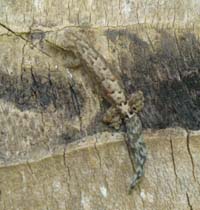
Gecko
(Lacertilia gekkonidae)

Habitat
Geckos live in a variety of warm habitats, including rainforests, deserts, and marshes. They are now found all over the world as pets. (especially the tokay gecko).
Physical Description
Geckos have short, wide, fleshy toes with large, backward-curved claws. Most geckos have stick toe pads, composed of microscopic Velcro-like hooked bristles (called setae) on the bottom of the feet; the bristles allow them to climb well, even on smooth surfaces or upside down. Geckos range in size from 1/2 to about 14 inches (1.5 to 35 cm) long; the largest gecko is the tokay gecko (Gecko gecko). The wide tail stores fat. The gecko's eyes are covered and protected by a transparent membrane; the gecko cleans this membrane with its long tongue.
Reproduction
Geckos hatch from eggs, Females usually lay 2 white, sticky eggs. The eggs are soft at first, but harden quickly. There is no parental care, in fact the geckos sometimes eat their own eggs.
Behavior
This lizard is quite arboreal, and can be seen in bushes and the lower branches of trees or thickets, but also spends time on the ground. At night it can be found sleeping in vine-covered thickets or in the open on low bushes. This is an alert, agile, speed-demon of a lizard. They are difficult to approach and even harder to photograph. Basilisks are capable of climbing, running, and swimming, all with equal facility. Adult males are particularly wary and may often be heard crashing to safety through the underbrush.
Food Habits
Geckos are carnivores (meat-eaters). They eat mostly insects (like crickets, springtails, and cockroaches) and mealworms, but they also eat young birds, eggs, and tiny mammals, hunting for their meals at night.
Predation
The geckos main predator is the snake. When a gecko is caught by its tail, it lets it go, which twitches for a while, allowing the gecko to escape. The gecko later grows another tail.
